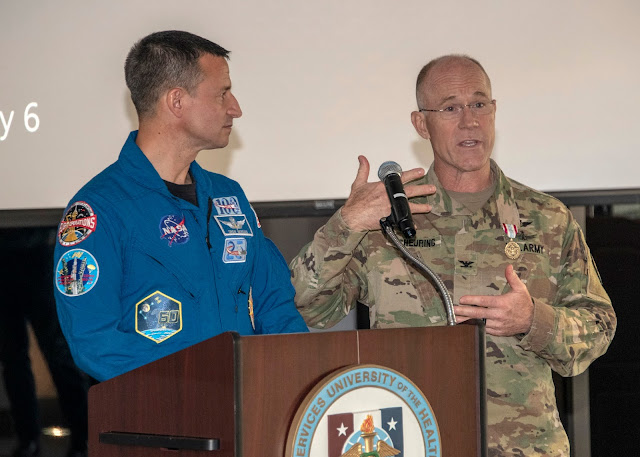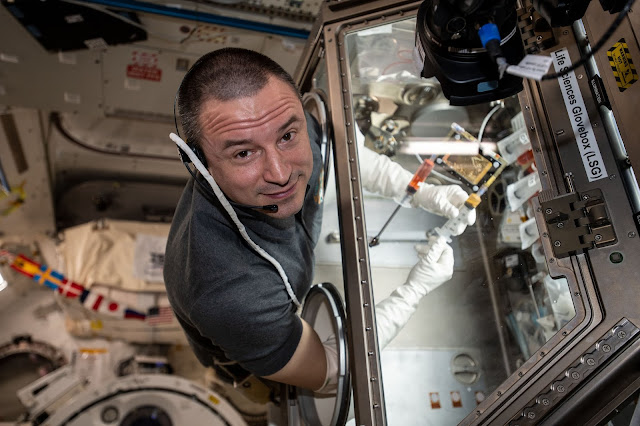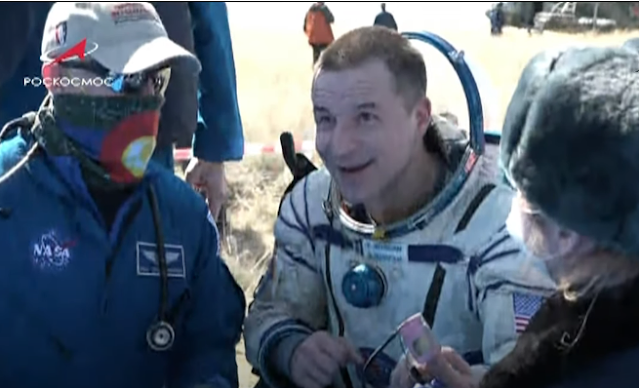Medicine Among the Stars: Astronaut Talks About His Experiences, Medical Treatments in Space
By Ian Neligh
In the fetal position, stuffed tightly into a craft originally designed by the Soviets, American Astronaut and Army Col. (Dr.) Andrew Morgan left the Earth onboard a Soyuz MS-13 from a spaceport in the Kazakhstan desert.
As the Russian spacecraft continued its shaking acceleration toward Earth’s thermosphere, Morgan felt the pressure of gravity double, triple, and then quadruple.
“It builds and builds, as we go through staging, and we continued to accelerate to our ultimate orbital speed of 17,500 mph,” Morgan said. “You feel that (pressure) until the moment the engines are cut off… then instantaneously you feel disoriented — I felt like I was upside down.”
The Uniformed Services University of Health Sciences (USU) alumnus left the planet on July 20, 2019, which was also the 50th anniversary of the historic Apollo 11 lunar landing.
Morgan spoke about his experiences and his subsequent nine-month stint onboard the International Space Station with USU students. He fielded questions about everything from the difficulty of living in microgravity to the future of medicine in space at the university on May 6.
Morgan, a West Point graduate, earned a Doctor of Medicine degree from USU in 2002. NASA chose him in 2013 to become one of the eight members of the 21st astronaut class. During nine months in space, he served as flight engineer, conducted seven spacewalks, totaling 45 hours and 48 minutes, and orbited the Earth 4,352 times.
“I took a little piece of my entire career and education with me to the space station,” Morgan said. “USU, the community, the students here, you all went with me, thank you very much for your support during my mission.”
Gravity Free
Morgan said living in microgravity was one of the most enjoyable things to experience during space travel. However, being weightless comes with its fair share of challenges.
“It takes weeks to get good at doing just basic things: going to the bathroom, personal hygiene, eating — all those things take time to get good at and learn how to do,” Morgan said. “You’re kind of like a baby all over again, you’re reborn in microgravity and learning how to do things that you previously knew how to do really well.”
Moving about the space station took thought and constant work as he learned to use his hands and feet to navigate around his new environment. If he was working with his hands and his feet weren’t secured, he floated away from what he was working on.
“When you arrive, during that first couple of weeks you’re thinking about every foot and hand placement as you go along and eventually it gets to the point where you don’t think about it,” Morgan said. After being on the space station for about three months, he said he had forgotten what gravity felt like.
Medicine in Space
During his time on the space station, Morgan took part in hundreds of biology experiments. While answering one audience question, he said science has yet to have all of the answers to what happens to human physiology while in space.
“One of my many areas of research is spine changes in astronauts who are 4.3 times more likely to have post-flight disk herniations than somebody who has not gone to space. Why? We don’t know what happens to the spine in space,” Scheuring said. “To answer your question: there’s a lot that we don’t know…I think this is a really exciting time for you and others who are interested in these research topics to get involved.”
Current and future astronauts are all screened for coronary and artery disease to help mitigate risk.
“It’s the screening that helps us mitigate and screen out the serious stuff,” Scheuring said. “As far as trauma, that can generally be engineered out from your system.”
Scheuring said he has worked with all the living Apollo astronauts and found the biggest concern they had while on the Moon was the risk of a suit puncture or muscular injuries because of the lighter gravity.
Treating Emergencies
While onboard the space station, Morgan said there is a “robust” telemedicine capability and the opportunity to speak with a flight surgeon at any moment.
“We can do basic ACLS and we can do basic minor procedures, plus we’ve got our own suite of medications available to us,” Morgan said, adding as a matter of procedure he spoke with his flight surgeon Scheuring once a week.
Morgan added in the event of a major incident, the crew would go back to Earth. At one point during his stay there were only three crew members on the space station. If something serious should have occurred then, they would have abandoned the space station which has never happened in its 20-year history.
“It’s made to have a crew on board performing functions. So if we have to batten down the hatches and depart that isn’t something that we would take lightly because it could potentially jeopardize the entire vehicle,” Morgan said.
According to Morgan, there is no capability now for performing a surgical operation in space.
“We have ventilator capability but it is pretty rudimentary and not something we would want to do long term,” Morgan said. “But as we go forward with the Artemis program and return to the Moon and eventually to Mars, now we are looking at missions that are much more protractive and much further away from Earth.”
He said a Martian voyage would take months and the likelihood of turning around to come back to Earth for a surgical emergency was unlikely.
“We’re having that conversation where ‘does someone need to be an actual physician in those longer and longer missions?’” Morgan said, adding people, like those in the audience, were needed to help drive that future discussion forward.
Back to Earth
On Aug. 17, 2020, the Soyuz MS-15 carrying Morgan and two other crew members undocked from the International Space Station, made an orbit and a half around the Earth and began to decelerate from 17,000 mph to enter the Earth’s atmosphere.
“I had a small window next to where I was seated; I could see the horizon change and I could start to see us getting closer to the Earth,” Morgan said. “For nine months I saw the earth from 250 miles up and it was abnormal to see the Earth so close, and getting closer as we started to decelerate.”
Morgan watched as fiery plasma washed across the window near his cramped seat and felt gravity once again begin to build up to four times that of Earth’s.
“It’s pretty uncomfortable because you haven’t felt gravity at all and all of a sudden you’re feeling four times your body weight continuously,” Morgan said.
The capsule’s parachute fired and he said it felt like they were being whipped around on a wild and disorienting ride before they hit the ground in a giant plume of dust, which he likened to being rear ended in a car at 35 mph.
“It’s a pretty good jolt,” Morgan said. “We tumbled and rolled a little bit. Within five minutes of hitting the ground the rescue forces were there.”
The first voice in English he heard was Scheuring’s telling him he was okay as he was taken out of the spacecraft. He had just finished his 272-day spaceflight, the fourth longest for an American.
“First of all I want to say that I’m overwhelmingly proud of all of you,” Morgan said to the gathered students, finishing the Q&A. “Know that this institution provides the best medicine anywhere on the Earth, or off the Earth, and you guys are part of that. You are entrusted with taking care of our Soldiers, Sailors, Airmen, Marines, Coast Guardsmen, Guardians — thank you for what you do.”









